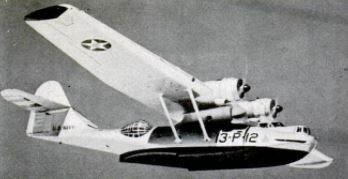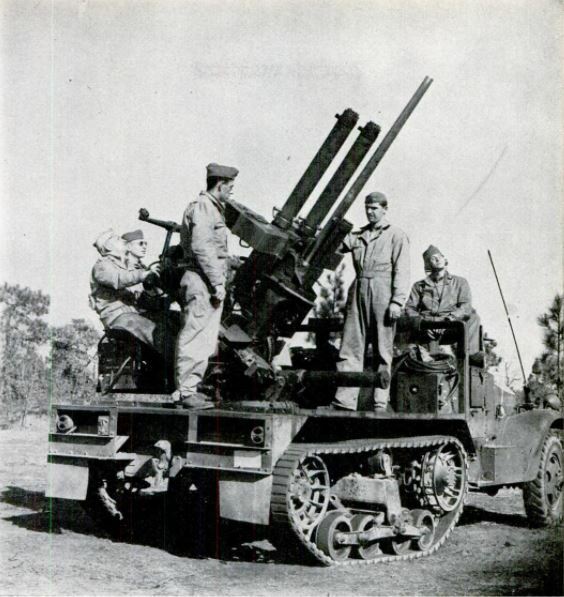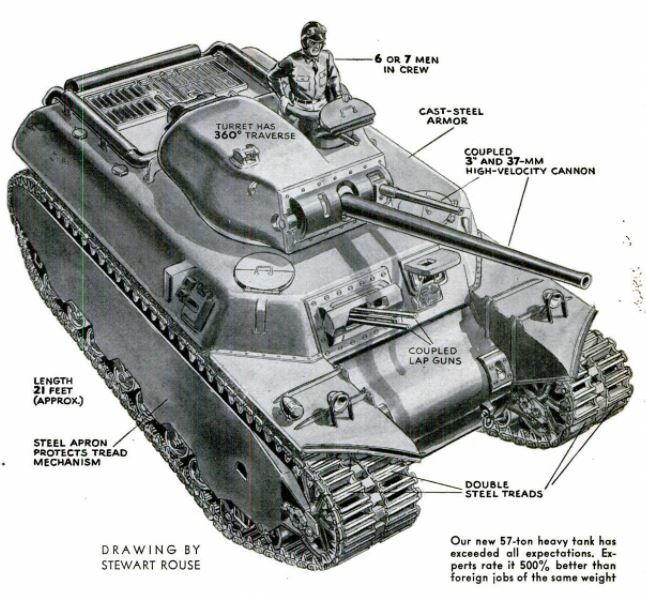-
Title (Dublin Core)
-
U.S. war technologies overview
-
Article Title and/or Image Caption (Dublin Core)
-
Title: For The Defense of - America Attacked
-
Subtitle: What Brave New Weapons Gird Our Fighting Men? Carl Dreher Reveals How Embattled Industry Met The Challenge of Axis Threats to Our Freedom
-
extracted text (Extract Text)
-
A “NEW” weapon is never altogether new.
Generally speaking, it is just an improved
machine for killing enemy personnel and de-
stroying enemy equipment. There is always
the possibility of hitting on something spec-
tacular and unprecedented, but Superman is a
character in a comic strip and there are no
supermen in the actual world of designing and
operating fighting machines. For the most
part military progress is a military engineer-
ing job in which a small or moderate improve-
ment here and another one there add up to a
decisive advantage in combat.
Our naval weapons are a case in point. The
things they do were almost all done in the first
world war and before. But the new ships do
them faster, more accurately, and with
more stunning force. Their speed is greater,
because their engines are more powerful,
and a further increase will soon be effected
when propellers are designed with controll-
able pitch so that the interaction of the
screw and the water pushes the hull ahead
with maximum efficiency. Their fire is more
accurate; the integrators and control de-
vices split finer hairs than they used to and
compensate for everything that is compens-
able. When the shell strikes it works great-
er havoc, because the rifle is bigger and the
propellant powder timed for just the right
shove in the barrel and perhaps the explo-
sive in the shell is even more violent. And,
not least important, the new ships are bet-
ter protected against the blows which they
in turn must sustain from the enemy's guns.
The new North Carolina is the last word
in battleships—until the next dreadnought
is commissioned. In guns, speed, and armor |
she has no present equal in our Navy or |
any other. Her nine 16-inch guns, arranged |
in two turrets forward and one aft, are de-
signed to hurl a broadside of some ten tons
of steel and TNT over 20 miles of ocean. |
She carries 20 five-inch rifles as secondary
armament. These are double-purpose, tur-
ret-mounted guns equally useful against sea
targets and aircraft. For close work against
dive bombers or torpedo planes, the North |
Carolina carries multiple-barreled 1.1 inch
pom-pom guns firing one-pound explosive |
shells, It is a formidable aggregation of
guns, something to be pondered over by the
naval strategists of the Axis powers—and |
they will have even more to think about
when the five battleships of the Montana
class take to the water with twelve 16-inch |
or 18-inch guns and secondary armament to
match,
In war ability to take it is as important
as ability to dish it out. Torpedoes, shells, |
and aerial bombs may shake the North |
Carolina, kill many of her crew, perhaps
disable and sink her, but it will require a
greater tonnage of explosives, more accu-
rately placed, to put her out of action than
any battleship of earlier design. Antitorpedo
buiges, watertight compartments, side ar-
mor probably 16 inches thick, and 10-inch
deck armor are among her known protec-
tive features. Nor does she lack auxiliary
protection for personnel in the form of top-
side armor as heavy as she can safely
carry. When she must, she can run as well
as chase, Her high-pressure turbines and
quadruple screws will probably enable her
to exceed her rated speed of 27 knots. It is
ironical to talk of safety in connection with
a combat ship, but the North Carolina is
about as safe a battleship as can be de-
signed with existing knowledge and ma-
terials.
The most highly industrialized countries,
strain as they may, cannot produce battle-
ships by the dozen. But the smaller com-
bat craft, which can be turned out on some-
thing more like a mass-production basis,
are just as important in the aggregate,
These types, moreover, are being improved
as rapidly as the ships of the line. New
destroyers are heavier, better-gunned, and
less vulnerable. The Kearny incident shows
that a modern destroyer is no longer the
type of vessel which only has to be hit once
and it is headed for the bottom. The mod-
ern destroyer is more like a light crulser
in this respect, and there will be even less
difference in the future. The typical Ameri
can destroyer of current design displaces
1,500 tons and up, with the heavy destroy-
ers which act as squadron leaders running
as high as 1,850 tons. On the offensive, such
ships, mounting eight to 16 torpedo tubes,
six 5-inch guns, and a heavy complement of
smaller high-angle guns for action against
airplanes, are a match not only for oppo-
nents of their own size but often for those
considerably larger. Their principal ad-
vantage is high speed and extreme maneu-
verability, consequent on thelr tremendous
power plants, which are about ten times
bigger, in engine horsepower per ton of hull,
than those of battleships. The destroyer,
of course, is the weapon par excellence
against the submarine, and it is equally
indispensable for screening, scouting, con-
voying, and auxiliary operations.
The destroyer is fast and maneuverable,
but the ultimate in speed and marine acrobat-
ics is reached in the motor torpedo boats,
which tear through the water, or rather on
it, at speeds around 60 miles an hour, and
turn corners like a boy on roller skates. Car-
rying three supercharged 1,350-horsepower
engines and a complement of eight men, a
boat of this type is by no means inexpensive
either in a monetary or a military sense.
Still, it can be risked and if necessary lost
with less over-all damage than a larger
fleet unit, and on the other hand it consti-
tutes an’ entirely disproportionate hazard
for any battleship at which it aims its four
torpedo tubes. If the battleship blows the
‘mosquito boats out of the water the battle-
ship has accomplished substantially noth-
ing, while if the torpedo finds its mark there
is likely to be one less battleship and the
mosquito boat has accomplished substan-
tially something. The essence of war is to
do the greatest possible damage with the
least possible expenditure of men and equip-
ment, and the mosquito boat is one of the
solutions of this problem as far as naval
warfare is concerned,
A navy worth its taxes is not a random
conglomeration of ships, but a technological
unity like any other producing organiza-
tion. It happens to produce destruction in-
stead of goods, but that in no wise lessens
its need for first-rate codrdination in opera-
tion, maintenance, and all the other highly
technical functions which Keep the wheels
turning. The range of these activities is so
great that even a cursory description is
impossible. But one phase of the Navy's
special operations warrants description be-
cause of its certain future importance, and
the more 50 in that it entails joint maneuv-
ers with the Army—always a difficult situa-
tion for both services. The job is that of
transporting troops over water.
In the last war, Army units carried over-
seas were regarded more or less as human
freight: so much space had to be provided
to accommodate so many men, and the ships
assigned to this duty were simply freighters
or passenger vessels rebuilt to carry as
many troops as possible. Since this was
before the days of air power and there was
no problem of landing troops on a hostile
shore, this system functioned successfully
enough at the time. But the present war
will call for establishing beach heads and
landing large bodies of troops under fire.
Consequently it has been necessary to adapt
existing oceangoing bottoms to carry sea-
going combat units with all their equip-
ment, ready for action, and in addition to
devise means of getting the men and ma-
tériel off the transports to the beach. The
latter job is handled by armed, self-pro-
pelled, ‘shallow-draft landing boats between
36 and 45 feet in length. Powered with a
250-horsepower motor and protected by a
machine-gun turret in the bow, such a boat
can bring to shore from 40 to 190 fully
armed men, or a smaller number of men
and a light tank. The speed is 25 knots.
When the boat runs up on the beach, the
hinged end is lowered to provide a run-
way for the tank or other vehicle.
The failures and fiascoes of American
plane production in World War I are an un-
pleasant memory. In the present war Amer-
ican plane design promises to write one of
the most brilliant chapters in the whole
history of air technology. Our only prob-
lem is reaching peak production in time.
The models themselves can hardly be
praised too highly—and this is not the
opinion of the men who built them, but of
foreign pilots who have been fighting in
them. The planes are good all along the
line, from the smallest pursuit craft to the
heaviest bomber. The light bomber or at-
tack plane—Douglas A-20-A—used by the
British as a night fighter under the name
“Havoc,” is only one example. In the United
States it is used largely as a reconnaissance
bomber and in close support of ground
troops. Flying at very low altitudes, the
A-20-A blazes away at a supply column
with its forward machine guns and drops
parachute-retarded fragmentation bombs
behind. The A-24 dive bomber metes out
similar punishment to point targets.
The Army's medium bombers fly as fast
as some of the best 1941 European fighters.
American heavy bombers climb to 37,000
feet and at the higher altitudes are capable
of running away from most fighters within
their bombing range of 3,000 miles. As a
sample of the heavier bombers to come, the
80-ton Douglas B-19, with a wing spread of
210 feet, has four engines totaling 8,000
horsepower which will fly it 6,000 miles at
a speed of 200 miles per hour. In the inter-
ceptor and pursuit line we have some of
the fastest models in the world. Something
may also be said of the less publicized train-
ing planes. In the long run, trainers may
De only less important in the winning of the
war than fighters and bombers.
The U.S. Navy, which has been building
some of its own planes since 1918, is con-
ceded to have the best naval air force in the
world. Its patrol bombers are vital for
coast defense, locating commerce raiders,
and the like, and in a war of attrition will
assume even greater importance. It will be
remembered that it was a Catalina (Con-
solidated PBY-5) flying boat which inter-
cepted the Bismarck on the voyage which
ended in her destruction. The Navy pio-
neered the technique of dive bombing and
in this field it has the Douglas SBD Daunt-
less, which corresponds to the Army's A-24,
and the Curtiss Helldiver, SB2C-1, which is
said to be the deadliest of the lot. Another
U.S. Navy development is the torpedo
bomber, and its Douglas Devastator (TBD)
is much better than the British Swordfish
which knocked out a good part of the Ital-
ian Navy at Taranto.
Naval antiaircraft equipment has already
been mentioned in connection with the
USS. North Carolina. During 1942 the
Army will have available in quantities its
4.7 inch AA gun, which should be effective
in the substratosphere region where heavy
bombers now travel. For medium altitudes
the Army, on the basis of European per-
formance and its own tests, has adopted
the 40-mm. funnel-mouthed Bofors auto-
matic cannon, which fires in bursts of four
or five rounds with a muzzle velocity of
2,850 feet per second and has a virtually
straight trajectory up to over 9,000 feet.
The weight of the projectile is 2.2 pounds,
and it will tear apart any airplane wing it
hits, or knock the plane out of control if it
explodes nearby. It is not a new weapon,
nor of American origin, but part of the
knack of winning wars con-
sists in holding on to old de-
signs until something mate-
rally better offers, and in
borrowing whatever is good,
wherever it is found.
The great new development
of the current war is, of
course, mechanized warfare,
of which the Nazis have been
the chief protagonists to date.
In this connection a recent
writer in the austere “Com-
mand and General Staff School Military
Review” quotes dryly, “There ain't no hoit
What can't be broke.” And that sums up
the situation accurately and briefly. Masses
of tanks and armored divisions are power-
ful weapons, but mechanism can cope with
mechanism—a principle which the hitherto
invincible German armies have already en-
countered in Russia, and will no doubt run
up against on other hattlefronts.
‘The trend in tanks has been toward heav-
for types, with armor good against at least
40-mm. projectiles. American. production
has been largely confined to the light tank
of about 15 tons, which has given a good
‘account of itself in Libya and, by reason of
high speed, good maneuverability, and me-
chanical excellence, can under some condi-
tions cope with equal numbers of German
medium tanks. It is normally equipped
With & 37-mm. gun and several machine
guns. During 1042 our 28-ton medium tank
will be brought into heavy production and
is expected to come up to the mechanical
standard of the light model. Armament
consists of a 75-mm. cannon, a 37-mm. can-
non, and machine guns in the turret and
cupola. The first heavy American tank
passed the Army tests at the Baldwin Loco-
motive Works early in December, 1041. It
welighs 57 tons, mounts one 3-inch and one
7-mm. cannon and a battery of machine
guns fore and aft, and has exceptionally
high speed for its weight.
The most obvious defense against the
tank is a better tank, or, if tanks are un-
available, an anti-tank gun heavy enough
to plerce the attacking tank's armor. Such
a gun must be self-propelled and lightly
armored to afford some protection to ita
operators. Essentially, therefore, it 1s a
light, single-gun tank In which armor has
been sacrificed for the sake of speed and
‘maneuverability. One tank specialist esti-
‘mates that a given number of AT guns can
cope with three to four times as many
tanks. The United States has developed |
self-propelled guns in calibers from 37-mm. |
to 155-mm., the 37-mm. and 75-mm. sizes
being designed especially for AT operations, |
or, as they have lately been designated, tank
destroyers. |
A recent development in
tank construction is the use
of cast or welded steel bodies.
The 57-ton type mentioned
above is of this type. Earlier
tanks, such as the American
product used by the British
in the Libyan campaign, were
riveted. When anything has
to withstand great pressures,
it is usually best to make it
one piece. In the case of the
tank, rivets have the additional disadvan-
tage that when struck by an armor-piercing
shell they may be driven into the interior
as secondary projectiles.
In an age of total war there is no practi-
cal distinction between military weapons
and the weapons of civilian production. An
improved method of geophysical explora-
tion for petroleum might help to win a war
as much as an improved machine gun. A
medical development, such as an improve-
ment in psychaitric tests used in selection
of student flyers, might be a military factor
of outstanding importance. Organization
itself is a weapon: a body like the National
Inventors Council, which sifts defense in-
ventions and separates a few kernels of
wheat from a vast volume of chaff, is not
to be underestimated. In this field of scien-
tific organization, incidentally, we are likely
to gain a long-term advantage, because
while the Nazis are superlatively organized
for the application of science to the ends of
destruction, their methods of internal sup-
pression and persecution are likely in the
end to dry up the sources of invention. Ger-
many nearly won the last war with Fritz
Haber's fixation of nitrogen from the air;
there will be no Haber for them this time,
for he happened to be a Jew.
The battleships, tanks, planes, guns, ve-
hicles with which our men will fight are
good, and the men are good. What then are
the prospects? All that can be said is that
the short-term outlook Is poor, the long-
term outlook favorable. We were not ready
when we entered the war and shall not be
thoroughly equipped for some time. But
we have the men and the machines and the
production capacity to see it through. And,
not of least importance, we are learning
from our mistakes. To work and to learn,
to be energetic and educable, is in the last
analysis the primary national weapon for
which there is no substitute in war.
-
Contributor (Dublin Core)
-
Carl Dreher (Article Writer)
-
Language (Dublin Core)
-
eng
-
Date Issued (Dublin Core)
-
1942-02
-
pages (Bibliographic Ontology)
-
72A-74
-
Rights (Dublin Core)
-
Public Domain (Google Digitized)
-
Archived by (Dublin Core)
-
Roberto Meneghetti
-
Marco Bortolami (editor)
 Popular Science Monthly, v. 140, n. 2, 1942
Popular Science Monthly, v. 140, n. 2, 1942






